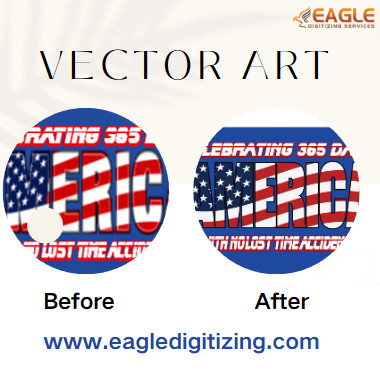What is about Print Media Makeover: Digitized Vector Arts Intro?
In an era where technology reigns supreme, the marriage of digitized vector and graphic arts with print media is a match made in heaven. This powerful combination has revolutionized the print industry, bringing forth an array of vibrant, precise, and dynamic visuals. From advertisements to editorial content, digitized art is redefining how we perceive printed materials.
The
Evolution of Print Media: From Traditional to Digital
Print media has come a long way from the rudimentary methods of woodblock printing in ancient China to the invention of the Gutenberg press. Today, we stand at the pinnacle of this evolution, where digital techniques seamlessly blend with traditional printing methods. The advent of computers and sophisticated software has enabled artists to create and manipulate images with unparalleled accuracy and efficiency, pushing the boundaries of creativity.
Why
Digitized Art Matters in Today's Print Media
Digitized art is not just a trend; it’s a necessity. In a world where visual communication is paramount, digitized art offers clarity, scalability, and versatility. It ensures that the final printed product is of the highest quality, with every detail meticulously rendered. This precision is particularly crucial for branding, where consistency across various media platforms is essential.
Key
Characteristics of Vector Graphics
Vector graphics boast several unique characteristics:
●
Scalability: Infinite resizing without loss of
clarity.
●
Editability: Easy manipulation of individual
elements.
●
Lightweight File Size: Typically smaller than
raster files, facilitating faster loading and easier sharing.
● Precision: Sharp and clean lines that are perfect for detailed work.
Popular
Software for Creating Vector Graphics
The creation of vector graphics is supported by various software
programs, each with its strengths.
Adobe Illustrator: The Industry
Standard
Adobe Illustrator stands at the forefront, offering a robust set of
tools and features that cater to professional designers. Its integration with
other Adobe Creative Cloud applications makes it a versatile choice for
comprehensive projects.
CorelDRAW: A Versatile
Alternative
CorelDRAW is known for its user-friendly interface and powerful
capabilities. It is a favorite among graphic designers for its flexibility and
extensive range of design tools.
Inkscape: The Open-Source Option
For those seeking a cost-effective solution, Inkscape offers a compelling open-source alternative. Despite being free, it boasts a comprehensive set of features that can rival its paid counterparts.
Graphic
Arts: Beyond Vectors
Vector graphics are just one facet of the broader spectrum of graphic
arts. This domain encompasses various styles and techniques, each contributing
to the rich tapestry of visual communication.
Exploring Different Types of Graphic
Art Styles
Graphic art styles are as diverse as the artists who create them. From
minimalist designs that emphasize simplicity and clean lines, to intricate,
detailed illustrations, the possibilities are endless. Each style has its own
place and purpose, whether it’s to convey a complex idea or evoke a specific
emotion.
The Role of Color Theory in
Graphic Arts
Color theory is fundamental in graphic design. Understanding how
colors interact, the emotions they evoke, and their cultural significance can
elevate a design from mundane to extraordinary. Effective use of color can
guide the viewer’s eye, create mood, and enhance readability.
Typography in Graphic Design:
Making Words Visually Appealing
Typography is more than just selecting a font; it’s about making text visually engaging and readable. The right typography can complement the overall design, reinforce the message, and ensure that the text is not just read but experienced.
The
Importance of Digitized Graphics in Print Media
Evolution of Digitized Graphics
in Print
Digitized graphics have undergone a significant evolution in print
media, transitioning from traditional hand-drawn illustrations to sophisticated
digital renderings. This evolution has been driven by advancements in technology,
enabling greater precision, flexibility, and creativity in graphic design.
Enhanced Visual Appeal
Digitized graphics have revolutionized the visual appeal of print
media, allowing for stunning imagery, vibrant colors, and intricate details
that captivate audiences and leave a lasting impression. From eye-catching
magazine layouts to dynamic poster designs, digitized graphics elevate the
aesthetic quality of printed materials.
Improved Communication and Message
Delivery
Incorporating digitized graphics into print media enhances communication and message delivery by providing visual cues and context that complement the written content. Infographics, for example, distill complex information into visually engaging formats, making it easier for readers to grasp key concepts.
Types
of Digitized Graphics Used in Print Media
Vector Graphics
Vector graphics use mathematical equations to define shapes and lines,
allowing for infinite scalability without loss of quality. They are ideal for
logos, illustrations, and other graphics that require crisp edges and smooth
curves.
Raster Graphics
Raster graphics are composed of pixels arranged in a grid, making them
suitable for photographs and complex imagery. While raster graphics can suffer
from pixelation when scaled up, they excel at capturing fine details and subtle
variations in color and tone.
Infographics
Infographics combine text, graphics, and data visualizations to convey
information in a concise and visually appealing manner. They are commonly used
in print media to present statistics, trends, and other complex information in
an easily digestible format.
Photographs
Photographs capture real-world scenes and subjects, adding authenticity and depth to print media. Advances in digital photography have expanded the possibilities for incorporating high-quality images into printed materials, from glossy magazine spreads to detailed product catalogs.
Benefits
of Using Digitized Graphics in Print Media
Enhanced Quality and Resolution
Digitized graphics offer superior quality and resolution compared to
traditional analog methods, ensuring sharp, clear images that stand out on the
printed page. This level of detail is essential for maintaining visual impact
and professionalism in print media.
Scalability Without Loss of Quality
One of the key advantages of digitized graphics is their scalability
without loss of quality. Vector graphics, in particular, can be resized
infinitely, making them versatile assets for print media projects of any size
or scale.
Versatility in Design
Digitized graphics afford designers unparalleled versatility in
creating visually striking print materials. With an array of tools and
techniques at their disposal, designers can experiment with different styles,
effects, and layouts to achieve the desired aesthetic and messaging objectives.
Efficiency in Production
By streamlining the design and production process, digitized graphics contribute to greater efficiency and cost-effectiveness in print media projects. Design revisions can be made quickly and easily, reducing turnaround times and minimizing production delays.
Examples
of How Digitized Graphics Enhance Print Media
Eye-Catching Magazine Layouts
Digitized graphics breathe life into magazine layouts, transforming
pages into immersive visual experiences. From striking cover images to dynamic
editorial spreads, digitized graphics draw readers in and encourage engagement
with the content.
Dynamic Poster Designs
Posters are a powerful medium for conveying messages and promoting
events, products, or causes. Digitized graphics enable designers to create
bold, attention-grabbing poster designs that command the viewer's attention and
leave a lasting impression.
Vibrant Brochure Illustrations
Brochures serve as marketing collateral for businesses and
organizations, providing essential information in a compact and visually
appealing format. Digitized graphics enhance brochure illustrations,
infographics, and product imagery, making them more engaging and persuasive to
prospective customers.
Interactive Print Advertisements
With advancements in augmented reality (AR) and QR code technology, print advertisements can now offer interactive experiences that blur the line between physical and digital media. Digitized graphics play a central role in these interactive experiences, seamlessly integrating with print materials to deliver immersive brand experiences.
Incorporating
Digitized Graphics into Print Media
Choosing the Right Graphic
Format
Selecting the appropriate graphic format is crucial for ensuring
optimal quality and compatibility in print media. Consider factors such as
resolution, color space, and file size when choosing between vector and raster
graphics formats. While JPEGs and PNGs are common, formats like PDF, EPS, and
SVG are preferred for vector graphics due to their scalability and
compatibility with various printing processes.
Preparing Graphics for Print
Before printing, graphics should be properly prepared to ensure
accurate reproduction and color fidelity. This may involve adjusting color
profiles, optimizing resolution, and converting graphics to the appropriate
color mode (e.g., CMYK for print).
Utilizing Graphic Design Software
Graphic design software such as Adobe Photoshop, Illustrator, and InDesign are indispensable tools for creating and manipulating digitized graphics for print media. These programs offer a wealth of features and capabilities for designing everything from logos and illustrations to brochures and advertisements.
Best
Practices for Using Digitized Graphics in Print Media
Maintaining Consistency Across
Platforms
Consistency is key to establishing a cohesive visual identity across
print media platforms. Use consistent color schemes, typography, and graphic
styles to reinforce brand recognition and ensure a seamless user experience for
readers.
Balancing Graphics with Text
Effective print media strikes a balance between graphics and text,
ensuring that visual elements complement and reinforce written content. Pay attention
to typography, layout, and hierarchy to create visually appealing and readable
print materials.
Considering Printing Techniques and
Constraints
Understanding the printing process and limitations is essential for
producing high-quality print media. Consider factors such as paper stock,
printing method, and finishing options when designing graphics for print, and
optimizing designs for the chosen printing techniques.
Ensuring Accessibility for All
Audiences
Print media should be accessible to all audiences, including those with visual or cognitive impairments. Incorporate accessibility features such as alt text for images, clear typography, and adequate contrast to ensure that printed materials are inclusive and easy to understand.
Challenges
and Solutions in Using Digitized Graphics in Print
File Size and Compatibility
Issues
Large file sizes and compatibility issues can pose challenges when
working with digitized graphics for print media. To address these issues,
optimize graphics for print by reducing file size, converting to appropriate
formats, and ensuring compatibility with printing software and hardware.
Color Management and Printing
Accuracy
Achieving accurate color reproduction in print media can be challenging
due to variations in color calibration and printing processes. Use color
management tools and techniques to calibrate monitors, proof prints, and ensure
consistency between digital and printed colors.
Copyright and Licensing Concerns
When using digitized graphics in print media, it's essential to
respect copyright and licensing agreements to avoid legal issues. Obtain proper
permissions for using copyrighted images, artwork, or other intellectual
property, and attribute sources appropriately to comply with copyright laws.
Technical Skill Requirements
Creating and manipulating digitized graphics for print media requires a certain level of technical skill and proficiency with graphic design software. Designers must be familiar with tools and techniques for image editing, vector drawing, typography, and layout design to produce high-quality print materials.
Future
Trends in Digitized Graphics and Print Media
Integration with Augmented
Reality and Virtual Reality
The integration of augmented reality (AR) and virtual reality (VR)
technologies presents exciting opportunities for enhancing print media with
interactive digital content. By overlaying digital graphics and animations onto
printed materials, publishers can create immersive experiences that engage and
delight audiences in new ways.
Personalization and
Customization in Print Design
Advancements in digital printing technologies enable personalized and customized print media tailored to individual preferences and demographics. From personalized advertisements to customized packaging, digitized graphics facilitate dynamic content creation and targeted marketing strategies.
Sustainability and Eco-Friendly Printing Practices
As environmental
concerns become increasingly prominent, there is a growing emphasis on
sustainability and eco-friendly printing practices in the print media industry.
And ealge digitizing, which provides vector graphics conversion services, can further support sustainability efforts by
reducing paper waste, minimizing ink usage, and optimizing printing processes
for eco-friendly materials and methods.
The fusion of digitized vector and graphic arts with print media opens up a world of possibilities. From creating visually stunning designs to ensuring precision and consistency, digitized art is transforming print media for the better. The potential is limitless, promising a future where creativity knows no bounds.
Now is the time to embrace digitized vector and graphic arts in your
print projects. Explore the software, experiment with different styles, and
stay abreast of the latest trends and innovations. By doing so, you’ll not only
enhance the quality of your print media but also stay ahead in a competitive
landscape.


